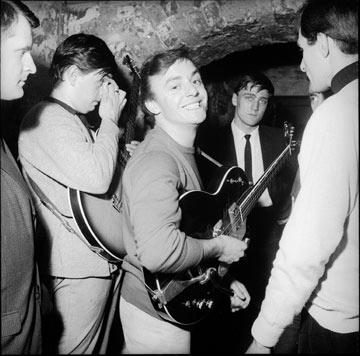Gerry and the Pacemakers

New exhibition of photographs of the popular Merseybeat group
Photographs which capture the wit, warmth and energy of Merseybeat group, Gerry and the Pacemakers on their rapid rise to fame, go on display at the Museum of Liverpool from 14 July to 7 January 2018.
Gerry and the Pacemakers: Hit Makers and Record Breakers is a new exhibition of more than 30 images by local photographers, Graham Spencer and Peter Kaye.
Singer, Gerry Marsden said:
“To see these images takes me back to those incredible days. From meeting fans to performing at the Cavern and photoshoots around Liverpool, they give a glimpse of what an exciting time it was.
“It is an honour to have the exhibition on display at the Museum of Liverpool which celebrates Liverpool as a hotbed of outstanding talent and creativity.”
Following The Beatles’ incredible success in 1963, the Merseybeat explosion catapulted local groups to national fame, in particular Gerry and the Pacemakers. In just 18 months, the group had six British top ten hits and were the first act ever to reach number one in the UK singles charts with their first three releases.
The exhibition includes evocative images of Gerry and the Pacemakers performing to enthusiastic crowds in the Cavern Club. The photographs capture Gerry Marsden’s charisma and connection with the crowd in the heady atmosphere of the world’s most famous cellar.
Arguably the group’s most enduring song, Ferry Cross the Mersey, is one of nine original tracks Gerry wrote for the film of the same name. Manager, Brian Epstein had been keen to capitalise on the group’s early success and the film is a fictionalised account of their remarkable story. The exhibition features a number of photographs taken on set during the film’s concert sequences at the Locarno Ballroom, Liverpool.
A selection of promotional images of the group larking about around St George’s Hall capture the group’s abundant confidence and sense of humour. Other images reveal the boys at their touring peak as well as relaxing with fellow Liverpool star, Cilla Black.
Claire Hunter, Assistant Curator of Urban History, said:
“Gerry and the Pacemakers: Hit Makers and Record Breakers is a great insight into a group who achieved incredible success. These photographs explore not only their significant accomplishments but also the group’s enduring bond to Liverpool, which more than five decades later, still has a role in the global image of the city.”
Notes to Editors
Museum of Liverpool
The Museum of Liverpool is one of the country’s most visited museums outside of London. It is the largest newly-built national museum in Britain for more than a century, demonstrating Liverpool’s unique contribution to the world. The first national museum devoted to the history of a regional city, it showcases popular culture while tackling social, historical and contemporary issues. It has attracted more than four million visitors since opening in July 2011. The prestigious Council of Europe Museum Prize for 2013 was awarded to the Museum for its commitment to human rights as well as its work with children and families from all backgrounds. The Museum has received generous support from several major funders, and grants from trusts and foundations, corporate support and individual donations. Major funders include the Northwest Regional Development Agency (NWDA), The European Regional Development Fund (ERDF), the Heritage Lottery Fund (HLF), the Department for Culture Media and Sport (DCMS),Garfield Weston Foundation and the Clore Duffield Foundation.
The Northwest Regional Development Agency (NWDA) was responsible for the sustainable economic development and regeneration of England’s Northwest and had five key priorities: Business, Skills and Education, People and Jobs, Infrastructure and Quality of Life.
The European Development Fund (ERDF) is making a real difference to people and businesses in the North West. With €755 million to invest between 2007 and 2013, ERDF is enhancing the competitiveness of the region’s economy by supporting growth in enterprise and employment. ERDF in the North West is managed by the Department for Communities and Local Government – for further information visit www.communities.gov.uk/erdf.
Using money raised through the National Lottery, the Heritage Lottery Fund (HLF) sustains and transforms a wide range of heritage for present and future generations to take part in, learn from and enjoy. From museums, parks and historic places to archaeology, natural environment and cultural traditions, we invest in every part of our diverse heritage. HLF has supported more than 30,000 projects allocating £4.5billion across the UK. www.hlf.org.uk
About National Museums Liverpool
National Museums Liverpool comprises eight venues, including some of the most visited museums in England outside of London. Our collections are among the most important and varied in Europe and contain everything from Impressionist paintings and rare beetles to a lifejacket from the Titanic. We attract around three million visitors every year. Our venues are the Museum of Liverpool, World Museum, the Walker Art Gallery, Merseyside Maritime Museum, International Slavery Museum, Border Force National Museum, Sudley House and the Lady Lever Art Gallery.
